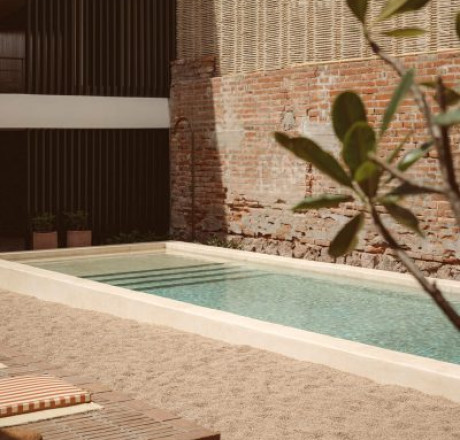Mexico
Mexico
Just Add Salt
Although tequila is one of Mexico’s most famous exports, people are often surprised to find that there is an actual place called Tequila. Similar to the regulations surrounding champagne, Mexican law states that agave-based spirits can only be labelled ‘tequila’ if they are produced in Jalisco or a limited number of regions in neighbouring states.
So, what is it like to visit Tequila? Picture a famous wine-producing region, only replace grapes with agave. Instead of cellar doors, visitors tour distilleries, known as tequilerias. For aficionados and neophytes alike, the experience is equal parts enlightening and throat-warming. Even people scarred by prior stomach-churning experiences with low-grade tequila find themselves savouring the refined flavours and smooth drinkability of the more highly regarded brews. Still, a solid session of tequila tasting tends to lead to intoxication very, very quickly. A formal experience marked by snobbish staff and uber-serious, pucker-faced ‘connoisseurs’ this is not.
This is rural Mexico, so forget white tableclothed fine-dining establishments. Instead, envisage a colourful colonial town with a bustling market and a handful of bars that heaves into the wee hours most nights of the week. Add a bold, rich and spicy regional cuisine and a dash of gregarious Mexican hospitality, and you’re getting close to imagining what the Tequila experience is about.
I arrive in Tequila’s historic main plaza on a sunny summer afternoon. Agents from the big-name distilleries, Jose Cuervo and Sauza, quickly descend on my travel partner and me in the hopes of selling us a tour. Each distillery has its own production methods and an incredible range of tequilas to try (the largest distilleries produce up to 40 different brands), but we kick off our tasting experience at La Cofradia, known for its more traditional-style production.
La Cofradia is a few kilometres out of town and the drive serves up a beautiful snapshot of Jalisco’s pastoral countryside. In the shadow of the 2700-metre Tequila Volcano, vibrant blue agave fields stretch as far as the eye can see. We end up being the only non-Mexican guests at La Cofradia, so the knowledgeable, English-speaking receptionist agrees to lock up the office for the afternoon and take us on a private tour of the estate. After strolling the plantations and learning about the lifecycle of the blue agave, we’re led inside the distillery where the agave hearts (known as piñas for their pineapple-like appearance) are steamed in giant ovens before being pressed to extract the sweet, distinctive nectar, ready to be fermented and distilled. The distillery tour is absorbing and walking the stunning grounds of La Cofradia is an experience in itself, but it’s the tastings that are the highlight of any tequileria trip.
La Cofradia charges 300 pesos (US$17) for tours, including transport to the estate and a margarita in its spectacular underground restaurant. Best of all, the ticket includes tasting as many house-made tequilas as you can handle. Our guide talks us through the unique characteristics of blanco (white or un-aged tequila), reposado (tequila rested in oak barrels for up to 11 months), and añejo (a deeply flavoured variety aged for a year or more). La Cofradia produces the Casa Noble brand, co-owned by Mexican–American guitar god Carlos Santana. It’s expensive tequila by anyone’s standard, but the Cofradia guides will happily ply you with all the top-shelf samples you desire. We try, only partially succeeding, to exercise some self-control, saving ourselves for another round of gourmet goodness back in town.
Returning to Tequila’s centro, we find the square alive with indigenous dance performances put on for the summer holidays. With fiery liquor still smouldering in our bellies, we hit the indoor market, hoping to soak up things with some street food specialities. Tequila’s market is almost solely devoted to the regional cuisine of Jalisco. A popular offering is birria, an intense savoury stew of tender slow-cooked goat. There’s also torta ahogada (drowned sandwich), a salsa-soaked bread roll filled with spicy pulled pork, as well as seafood dishes from the coast. Of course, there are taco stands aplenty, and the smell of smoky, sizzling meat fills the air.
Sated from our street food extravaganza, we head for the corridor of bars lining the main square just as a rainstorm makes its thunderous presence known. We race to the nearest bar, where the undercover terrace is packed with punters – bottles of tequila in hand – ready for a long night of revelling. It is Sunday evening, after all. As the sound of Jalisco’s other famous export, the mariachi band, begins to fill the air, patrons spill out onto cobblestone streets. Dancing arm in arm in the pouring rain, they embody the Latin tradition for flamboyant displays of romance, fuelled by tequila – the lifeblood of this joyous town.
Sangrita (meaning ‘little blood’) is a traditional accompaniment to tequila blanco, although it also pairs well with the peppery taste of reposado. Its sweet and tart flavour helps temper the heat of the alcohol. Rather than being gulped down as a chaser, it’s best used as a palate cleanser in between sips of good tequila.
Ingredients
30ml freshly squeezed orange juice
20–30ml freshly squeezed lime juice
15ml real pomegranate grenadine
3 dashes of hot sauce or ¼ tsp chilli powder
Method
Mix all ingredients together, chill and serve with your favourite tequila or mezcal.
 (
(















